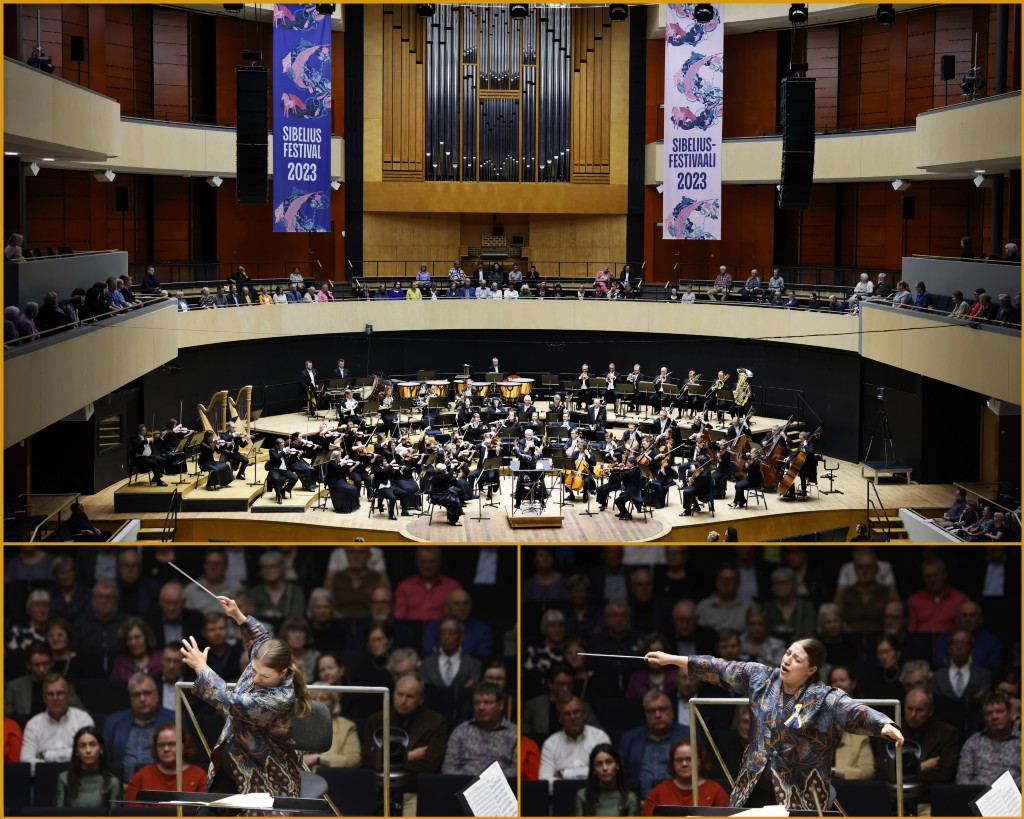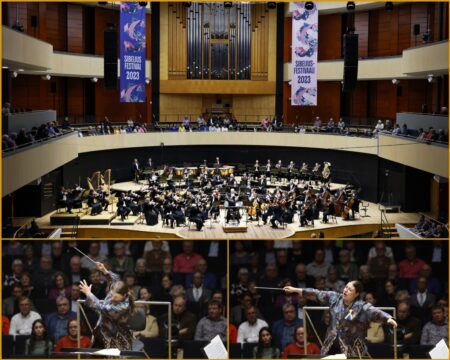The Sibelius Festival, under the artistic direction of conductor Dalia Stasevska, annually illuminates the wooded and warm acoustics of the Sibeliustalo, the Sibelius Hall, located on the shores of Lake Lahti. The surrounding landscape, filled with pines and birch trees, provides a splendid backdrop for the music of the Master of Ainola. There is no substitute for a journey to Finland, especially to hear this wonderful music performed with dedication and conviction by an orchestra wholly devoted to the cause of Finland's most famous composer. Conductor Osmo Vänskä had successfully elevated the Lahti Symphony Orchestra to the ranks of Finland's top orchestras, and their recordings of the symphonies and tone poems under the excellent label Bis remain among the most recommended complete sets.
This year, the Festival has chosen to focus on Sibelius's travels where he excelled as a conductor. Dalia Stasevska has earned a quite good reputation for historical accuracy, often proposing reconstructions of programs as they were played during the composer's time. The opening of the 2023 edition replicates the concert from June 4, 1914, held at the "The Shed" concert hall of the Norfolk Music Festival in Connecticut, approximately 100 miles from New York. Sibelius conducted this concert, and the podium was adorned with the colors of both the American and Finnish national flags. At that time, the orchestra, which the composer had described as "wonderful, surpassing anything we have in Europe," consisted of musicians from three of the top American orchestras : the New York Philharmonic, the Metropolitan Opera Orchestra, and the Boston Symphony Orchestra. It was Sibelius's greatest triumph, an event that all spectators considered the musical highlight of their lives, with unparalleled ovation and overwhelming enthusiasm. During this tour, where Sibelius was welcomed like a king, he received an honorary degree from Yale University. This was the composer's only visit to the United States, and the immense joy was soon overshadowed by the outbreak of World War I. This emphasizes the special emotion that a concert like this one in September 2023, nearly 110 years to the day after its original performance, can hold, especially when the Ukrainian-born conductor interprets Finlandia as a resounding cry of resistance against Russian oppression.
The next part of the concert features the music from the incidental music King Christian II op. 27, which foreshadows the First Symphony and has a more elegiac and notably Russian inspiration. The Nocturne highlights silence, with lovely moments in the Elegy (beautiful clarinets), while the Ballade, the pinnacle of the work, presents a kind of triumphant march in the spirit of Lemminkäinen Legends, with distinctly Slavic passages that occasionally evoke Tchaikovsky. It is a martial and rapid section, a grand conclusion to the piece, ending with a beautiful fanfare.
The following piece, one of Sibelius's most famous compositions, The Swan of Tuonela, op. 22, No. 2, is a section of the Lemminkäinen Legends, inspired by chapter XIV of the Kalevala epic. In this melancholic work, "Tuonela" refers to the realm of the Dead in Finnish mythology, a place surrounded by a dark river where swims a swan. The English horn plays a central role in this piece, symbolizing the funereal swan and creating a dark and melancholic atmosphere, evoking themes of death and transition to the afterlife. The double basses reaffirm their excellent performance, offering a deep and eerie resonance, while the high register of the violins clearly follows in the footsteps of Lohengrin. The English horn, again, reminiscent of a Tristanesque shepherd's melody, is fascinating. The poetry that emerges from this piece showcases a more confident and expressive orchestra, offering beautiful ethereal moments.
Without a doubt, and as the applause confirms, the highlight of this evening is the performance of The Oceanides, op. 73, a fascinating symphonic poem with a much more elaborate and audacious composition. Since this concert recreates the famous premiere of the work, let us recall the turbulent genesis of the piece itself: in April 1914, Sibelius had sent the score of his composition to the United Statesnited States, where he had titled it Rondeau der Wellen (this intermediate version of the symphonic poem is commonly referred to as the "Yale" version). However, despite already sending the manuscript to Norfolk, Sibelius was not entirely satisfied with the composition and immediately began a complete revision and overhaul, expressing his enthusiasm for the project: “Isn't it just like me to rework the symphonic poem – at the moment I am ablaze with it.” Typically, Sibelius revised his compositions either when preparing them for publication or after hearing them performed in concert. In the case of the Yale version, the invitation to personally attend the music festival may have prompted Sibelius to critically reevaluate the symphonic poem. The differences between the original version and the final version of the symphonic poem are significant. Sibelius not only transposed the piece to D major but also added a spectacular climax. Nevertheless, the orchestration remained largely the same, with the addition of a single trumpet. As the trip to America approached, Sibelius worked feverishly to complete the revisions. Aino, the composer's wife, described the scene at Ainola during this time:
"The trip to America is approaching. 'Rondeau der Wellen' is not yet complete. There is terrible haste… the score is only half-ready. The copyist, Mr. Kauppi, is staying with us and writing night and day… It is only because of Jean’s [Sibelius] energy that we are making progress… We lit a lamp in the dining room, a chandelier in the living room; it was a festive moment. I didn't dare say a word. I just checked that everything was in order. Then I went to bed, and Jean stayed up. All night long, I could hear his footsteps, alternating with softly played music."
Sibelius continued to make changes to the final version of the symphonic poem as he sailed across the Atlantic Ocean aboard the SS Kaiser Wilhelm II and even during rehearsals in Norfolk. However, these last-minute changes must have been relatively minor, as the orchestral parts had been copied before his departure from Finland. Sibelius was thrilled with the new piece and wrote to Aino : "It's as though I have found myself, and more besides. The Fourth Symphony was the start. But in this piece, there is so much more. There are passages in it that drive me crazy. Such poetry."
One can only agree with the composer, and the Lahti Symphony Orchestra successfully captures the iodine fever of this piece, which goes beyond the impressionism that some may have detected in it. The original Finnish title, Aallottaret literally "Nymphs of the Waves" or "Spirits of the Waves," is a highly evocative musical equivalent of the canvas by Sibelius's friend Akseli Gallen-Kallela. Flutes and harps glisten in a sensual rustling that explicitly references Greek mythology's nymphs. It rumbles and murmurs, with Sibelius's typical method of self-generating musical cells proliferating organically, creating a highly evocative vision of the sea. The music is traversed by currents and whirlpools engendering one another, a continuous flow that anticipates the audacity of the Seventh Symphony's single movement, building tension to a paroxysmal maelstrom, a Shakespearean storm where one can detect a fusion of Wagner and Debussy. The critic Olin Downes had described this page as “the finest evocation of the sea which has ever been produced in music.” As interpreted with the necessary ardor and a sense of dramatic progression, The Oceanides truly appear as a maritime anticipation of Sibelius's ultimate opus, Tapiola. The disciplined strings are just perfect from the beginning to the stunning end.
With the resources of the Lahti Symphony Orchestra, composed of numerous promising and dedicated young musicians, and the refreshing enthusiasm of the conductor, we were able to immerse ourselves a little bit in the atmosphere of one of Sibelius's most fabulous concerts in his career.
Philippe Rosset
September 7, 2023



